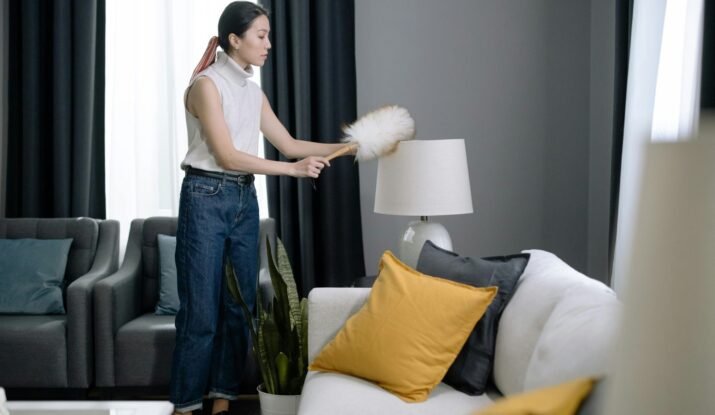Table of Contents
Feeling overwhelmed by relentless dust in your space? It’s time to reassess your strategy beyond the usual dusting routine. Tackling the dust issue doesn’t necessarily mean cleaning harder or more often; it’s about cleaning smarter.
Discover effective ways to significantly cut down on the dust gathering on every surface in your home. From selecting the right cleaning tools to adjusting your home’s decor and maintenance, we’ve compiled a list of the top tactics to help clear the air and reduce dust, ensuring a cleaner, more comfortable environment for you and your family.

Why is my house so dusty?
Does it seem like no matter how often you dust, it settles right back again, leaving you in a never-ending battle with dusty surfaces? You’re not alone. Many homeowners share the frustration of a dusty house, but understanding the causes can help you tackle the issue effectively.
Dust accumulates from various sources: outdoor dirt carried in by shoes and pets, skin cells, fabric fibers, and even microscopic particles from outer space! Homes with high foot traffic or those near construction sites may find more dust piling up. Your HVAC system can also be a culprit, circulating dust throughout your house, especially if filters are not regularly changed or if the ducts need cleaning.
Another often overlooked factor is the presence of clutter. More items mean more surfaces for dust to settle on, making it harder to keep up with cleaning. Humidity levels also play a role; too low, and dust becomes airborne more easily. And let’s not forget air filters; using low-quality filters or neglecting to change them can significantly increase dust levels.
Begin Dusting from the Top Down
When it comes to dusting your home, gravity is the unsung hero that guides the best strategy – always start from the top and work your way down. This ‘Dust High To Low’ method ensures that any dust particles dislodged from higher surfaces won’t settle on areas you’ve already cleaned below.
Begin with the highest items like ceiling fans, shelves, and light fixtures. Then, move on to mid-level surfaces such as countertops, furniture, and electronics. Finally, finish with the lowest points including baseboards and floors. By following this top-down approach, you’re not just shifting dust around but actually removing it from your living spaces.
Use Microfiber Cloths for Superior Dusting

How Microfiber Works: The magic of microfiber lies in its construction. These cloths are made from fibers that are finer than a strand of silk, creating a net-like surface that traps and holds dust, dirt, and even microscopic particles. Unlike traditional cleaning cloths that may simply push dust around, microfiber cloths effectively grab and remove it from surfaces.
Versatility: One of the great advantages of microfiber is its versatility. These cloths can be used dry for dusting and polishing or damp for more intensive cleaning tasks. They are safe to use on a wide range of surfaces, including delicate ones like computer screens and TVs, without leaving scratches or streaks.
Ideal for Allergy Sufferers: For those with allergies, microfiber is a blessing. By effectively trapping dust and allergens, these cloths can help reduce the airborne particles that trigger allergy symptoms, contributing to a healthier indoor environment.
Avoid Dry Dusting
When you dry dust, you’re essentially moving dust around rather than removing it. This not only redistributes the dust to other areas of your home but can also send particles airborne, worsening indoor air quality and potentially aggravating allergies and respiratory issues.
Instead of dry dusting, consider using a damp cloth or a microfiber cloth. The moisture helps to trap and hold the dust, effectively removing it from surfaces. This method ensures that dust is captured and removed, rather than just being pushed around. For even better results, you can use a mild cleaning solution or just water to dampen the cloth, which will help in picking up more dust and providing a more thorough clean.
Dust Ceiling Fans
Fans collect a significant amount of dust on their blades and housing. This can not only affect their efficiency but also contribute to circulating allergens and dust particles in the air.
Effective Cleaning Tips:
- Turn off the fan before cleaning.
- Use a step stool or ladder to safely reach the fan.
- Employ a duster with an extendable handle or a damp cloth to gently wipe each blade.
- Don’t forget to clean the top of the blades and the fan housing.
Opt for Blinds or Washable Curtains to Minimize Dust

Managing dust in your home goes beyond regular cleaning surfaces; it extends to the type of window coverings you choose. Heavy drapes, while often luxurious and beautiful, are notorious for collecting dust. Over time, they can become a hidden source of allergens, detracting from the overall air quality in your home.
Blinds or washable curtains are presented as a smarter choice for those looking to minimize dust. Blinds can be easily wiped down, preventing dust from settling, and washable curtains can go straight into the laundry, ensuring that they’re not just visually clean but truly free of dust and allergens.
When selecting window treatments, considering their maintenance and impact on your home’s dust levels is crucial. By opting for materials that don’t harbor dust or are easier to clean, you contribute to a healthier and more allergen-friendly environment. This is particularly important for homes with pets, children, or individuals with allergies. Simple choices in your window coverings can make a significant difference in the ongoing battle against household dust.
Reduce Household Dust with a Whole-House Humidifier

Installing a whole-house humidifier can be a game-changer in your quest to combat dust accumulation within your living spaces. While it may not eradicate dust entirely, its role in dust management is significant and operates on a simple scientific principle: dry air can exacerbate dust presence in your home by generating static electricity. This static charge not only helps dust particles to multiply but also enables them to adhere to various surfaces, making your home look dusty more often.
The strategy behind using a humidifier for dust control is to introduce more moisture into the air. When the air is humidified, dust particles absorb the moisture, which makes them heavier. Consequently, instead of floating around and settling on every conceivable surface, these heavier particles drop to the floor. This can make cleaning efforts more effective, as dust can be more easily swept or vacuumed up from the ground, rather than persistently coating furniture and hard-to-reach areas.
Not only does this help in maintaining a cleaner home, but it also can contribute to better indoor air quality and comfort, particularly for those who are prone to allergies. By keeping your home’s humidity at an optimal level, you can help ensure that dust is less of a floating menace and more of a manageable inconvenience.
Professional Help
Cleanmate in Philadelphia offers a comprehensive solution to combat household dust, utilizingHEPA filter vacuums and deep cleaning techniques to effectively remove and prevent dust buildup. Targeting hard-to-reach areas and items like upholstery and carpets, Cleanmate ensures a thorough clean. Their commitment to green cleaning practices also means a safer environment for your family, making your home cleaner and healthier.
Request a Free Online Estimate or Call (267) 433 – 3399 Today!
Helpful links:



Comments (2)
puravive reviews
This is an amazing page. The outstanding information reveals the owner’s accountability. I’m in awe and eagerly await more amazing postings like this one.
Brian
Thank you so much for your kind words and positive review!